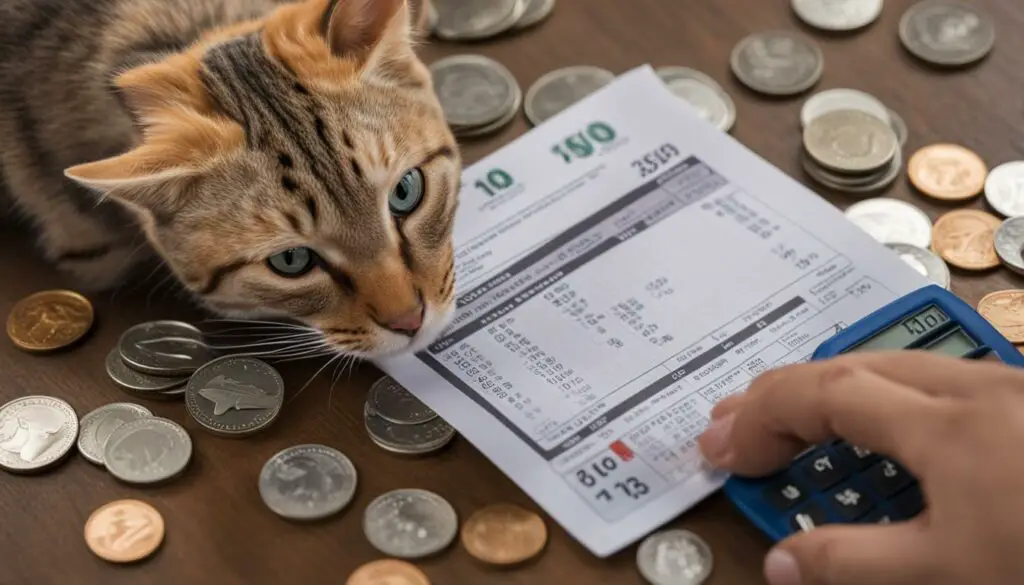When it comes to our furry feline friends, their dental health is just as important as their overall well-being. As a cat owner, you may have heard about the potential need for tooth extractions and the associated cost. In this article, I will delve into the intricacies of cat tooth extraction cost, helping you understand the factors that contribute to the overall expense.
Before we dive into the details, it’s essential to recognize that the cost of cat tooth extraction can vary based on several factors. These factors include the location, complexity of the procedure, the veterinarian’s experience, and any additional treatments that may be required. Therefore, it’s crucial to consult with your veterinarian to get a more accurate estimate tailored to your specific cat’s needs.
Key Takeaways:
- The cost of cat tooth extraction can vary based on factors such as location, complexity, and additional treatments.
- Consulting with your veterinarian is crucial to getting an accurate estimate for your specific cat’s needs.
- Maintaining proper dental health is crucial for your cat’s overall well-being.
- Dental problems such as periodontal disease and gingivitis can cause pain and discomfort.
- Regular dental care, including professional cleanings and tooth extractions, can help prevent dental problems.
Understanding the Importance of Cat Dental Health
Maintaining proper dental health in cats is crucial for their overall well-being. Poor oral hygiene can lead to various dental problems such as periodontal disease and gingivitis, which can cause pain, discomfort, and even tooth loss. Regular dental care, including professional cleanings and tooth extractions when necessary, can help prevent these issues and ensure your cat’s oral health.
Periodontal disease is one of the most common dental conditions in cats. It occurs when plaque and tartar build up on the teeth, leading to inflammation of the gums and potentially damaging the supporting structures of the teeth. If left untreated, periodontal disease can cause tooth loss and may even affect other organs in the body, such as the heart and kidneys.
Gingivitis is another common dental issue in cats, characterized by inflammation and swelling of the gums. It can cause bleeding, pain, and discomfort, making it difficult for cats to eat and groom themselves properly. Regular dental check-ups and professional cleanings can help identify and address gingivitis before it progresses.
By prioritizing your cat’s dental health, you can ensure their overall well-being and prevent the need for more extensive dental treatments in the future. Regular brushing of your cat’s teeth, providing dental-friendly treats and toys, and scheduling routine dental examinations with your veterinarian are all important steps in maintaining their oral health.
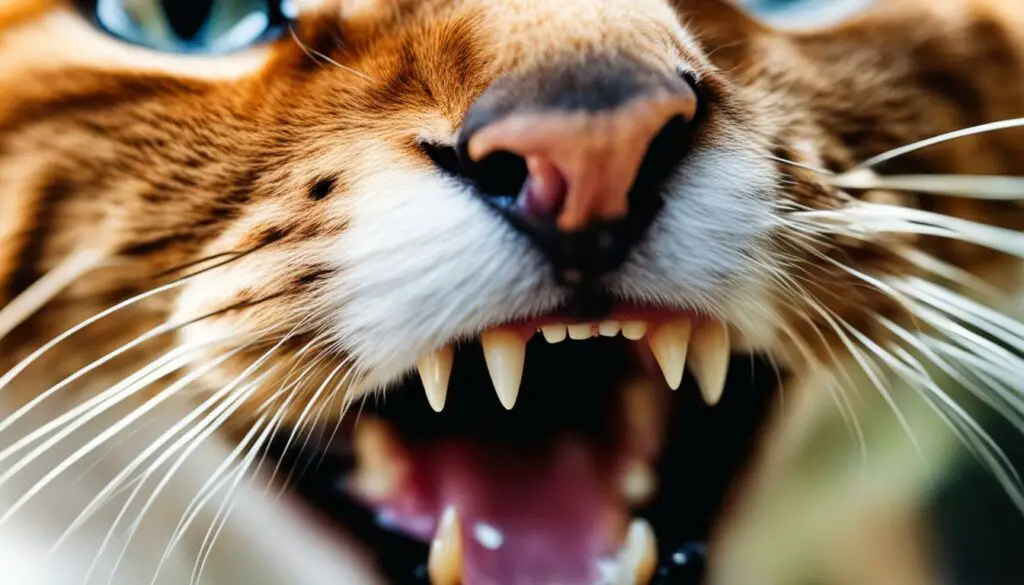
References:
- https://www.avma.org/resources-tools/pet-owners/petcare/dental-health-pets
- https://www.aaha.org/pet-owner/pet-owner-education/dental-care-for-pets/feline-dental-care/
Common Reasons for Cat Tooth Extraction
In this section, I will discuss the common reasons why a cat may require tooth extraction. Dental problems in cats can arise due to various factors, and extraction may be necessary to alleviate pain and prevent further complications.
Dental Problems
Cats can experience a range of dental problems that may necessitate tooth extraction. One common issue is severe dental decay or infection, which can result from poor oral hygiene or underlying health conditions. These conditions can cause significant pain and discomfort for the cat, making extraction the most viable option to improve their quality of life.
Another reason for tooth extraction is the presence of abscesses. An abscess is a pus-filled pocket that forms as a result of a dental infection. If left untreated, abscesses can lead to severe pain, swelling, and even damage to surrounding tissues. Extraction helps eliminate the source of infection and prevent the spread of bacteria.
Root Canal Failure
In some cases, a root canal procedure may be attempted to save a tooth. However, if the root canal fails or does not effectively address the underlying dental issue, extraction may be necessary. Root canal failure can occur due to factors such as inadequate cleaning of the root canal or persistent infection. Extracting the tooth can help prevent further complications and ensure the cat’s oral health.
Fractured Teeth
Fractured teeth are another common reason for tooth extraction in cats. A fractured tooth can be painful and may expose the sensitive inner structures, making it susceptible to infection. Depending on the location and severity of the fracture, extraction may be the best option to alleviate pain and prevent further damage.
It is important to note that tooth extraction in cats should always be performed by a qualified veterinarian. They will conduct a thorough examination and recommend the most suitable course of action based on the cat’s specific dental problems.
| Common Reasons for Cat Tooth Extraction | Examples |
|---|---|
| Dental Decay or Infection | Severe decay, chronic infection |
| Abscess | Pus-filled pocket due to infection |
| Root Canal Failure | Inadequate cleaning, persistent infection |
| Fractured Teeth | Broken or chipped tooth |
“Tooth extraction may be necessary to alleviate pain and prevent further complications caused by dental problems in cats.”
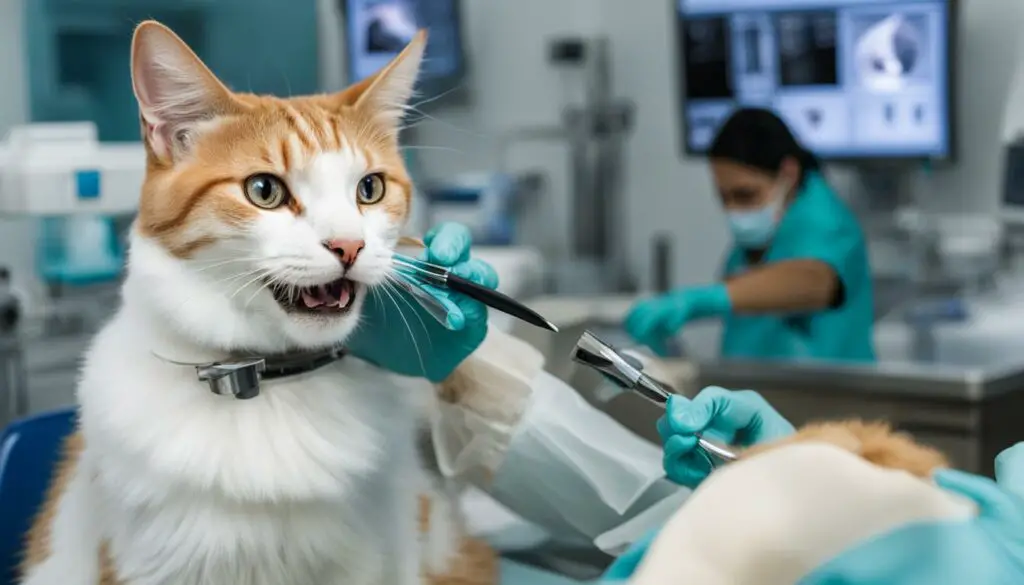
In the next section, we will explore the dental extraction procedure for cats, including the use of anesthesia and various extraction techniques.
The Dental Extraction Procedure for Cats
When it comes to cat tooth extraction, the procedure typically involves several steps to ensure the cat’s comfort and safety. Anesthesia or sedation is commonly used to ensure that the cat remains still during the extraction process. This allows the veterinarian to perform the procedure accurately and minimizes any discomfort for the cat.
Pain management techniques are an essential part of the dental extraction procedure. This ensures that the cat is as comfortable as possible during and after the extraction. Your veterinarian may prescribe pain medication or recommend other pain management strategies to help your cat through the recovery process.
The extraction technique used can vary depending on the specific tooth and the complexity of the extraction. Your veterinarian will assess the tooth’s condition and determine the best method to remove it. This may involve techniques such as simple extractions, surgical extractions, or the use of specialized instruments.
Pain Management Techniques for Dental Extraction
Dental extractions can cause discomfort for cats, but pain management is crucial to ensure a smooth recovery. Here are some common pain management techniques used during cat dental extractions:
- Prescribing pain medication: Your veterinarian may prescribe pain medication for your cat to manage any post-extraction pain.
- Local anesthetic: Your veterinarian may use a local anesthetic to numb the extraction site during the procedure.
- Non-steroidal anti-inflammatory drugs (NSAIDs): These medications can help reduce pain and inflammation after the extraction.
- Cooling gels or sprays: These topical treatments can help soothe the gums and provide short-term pain relief.
| Extraction Technique | Description |
|---|---|
| Simple Extraction | A straightforward extraction where the tooth is loosened and removed with forceps. |
| Surgical Extraction | A more complex extraction that may involve making an incision in the gum and removing the tooth in sections. |
| Use of Specialized Instruments | In some cases, specialized instruments may be used to remove the tooth, especially if it is impacted or embedded. |
It is important to follow your veterinarian’s post-operative care instructions to ensure a smooth recovery for your cat. This may include administering any prescribed medications, monitoring the extraction site for signs of infection, and providing a soft diet for your cat during the healing process.
By understanding the dental extraction procedure and the importance of pain management, you can ensure the best possible outcome for your cat’s oral health.
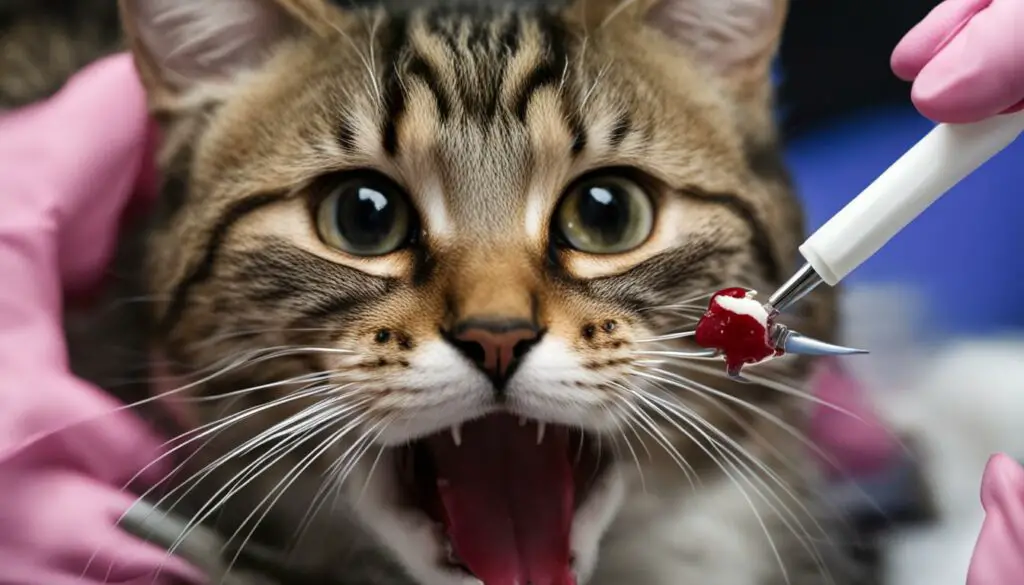
Recovery and Post-Operative Care
After a cat undergoes a tooth extraction procedure, proper recovery and post-operative care are crucial for their well-being. During this period, it is essential to provide the necessary support and follow your veterinarian’s instructions to ensure a smooth healing process.
One key aspect of recovery is managing any discomfort or pain your cat may experience. Your veterinarian may prescribe pain medication to help alleviate any post-operative pain. It is important to administer the medication as directed and monitor your cat for any signs of discomfort or distress.
In addition to pain management, your veterinarian may use dental sutures to aid in the healing process. Dental sutures are stitches that help close the extraction site and promote proper healing. Your veterinarian will provide guidance on caring for the sutures, such as avoiding activities that may disrupt them or cause irritation.
| Post-Operative Care Tips |
|---|
| Provide a comfortable and quiet recovery space for your cat |
| Monitor your cat’s behavior and report any changes to your veterinarian |
| Follow any dietary restrictions or modifications recommended by your veterinarian |
| Keep your cat’s mouth clean by gently wiping the area around the extraction site with a damp cloth |
| Avoid giving your cat hard or chewy treats that may cause discomfort or disrupt the healing process |
“Recovery after a tooth extraction procedure is crucial for your cat’s well-being. Proper post-operative care, including pain management and caring for dental sutures, is essential for a smooth healing process.”
It is important to closely monitor your cat’s recovery and report any concerns or changes in behavior to your veterinarian. This may include excessive swelling, bleeding, or signs of infection such as discharge or a foul odor. By following the post-operative care instructions provided by your veterinarian, you can help ensure a successful recovery and optimal oral health for your beloved feline companion.
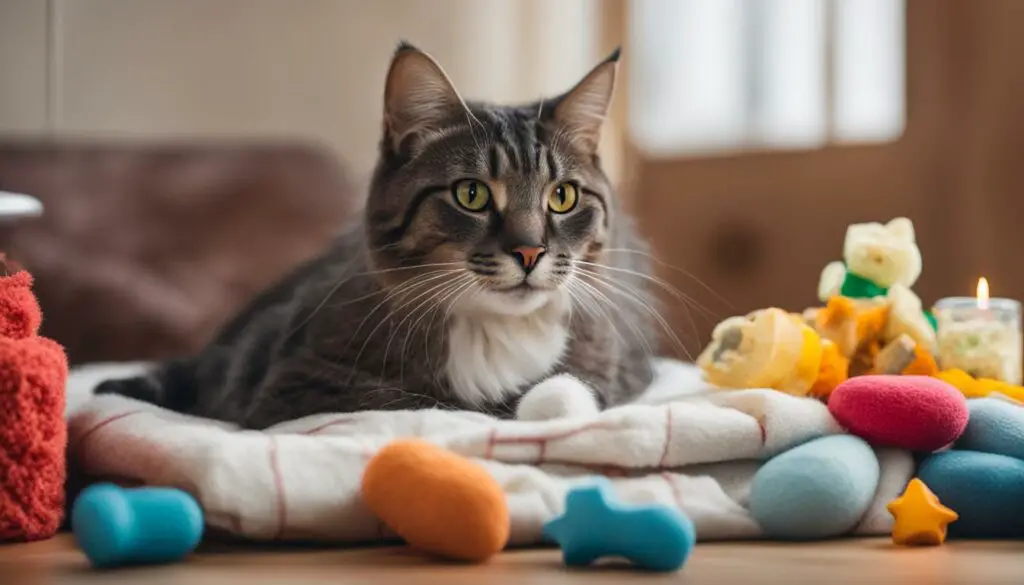
Potential Complications and Risks
When it comes to cat tooth extraction, there are potential complications and risks that pet owners should be aware of. While this procedure is generally safe and performed regularly by veterinarians, it is important to understand the potential issues that may arise.
One of the main complications of cat tooth extraction is bleeding. During the procedure, the tooth’s blood vessels are disrupted, and some bleeding is to be expected. However, excessive bleeding or difficulty in stopping the bleeding can occur in rare cases. Your veterinarian will take the necessary precautions to minimize the risk of excessive bleeding and address it promptly if it occurs.
Infection is another potential risk associated with tooth extraction. Despite proper sterilization techniques, bacteria can still enter the extraction site, leading to an infection. Your veterinarian will prescribe antibiotics and provide instructions for proper post-operative care to minimize the risk of infection.
It is crucial to closely monitor your cat’s recovery process and contact your veterinarian if you notice any signs of excessive bleeding, swelling, or signs of infection such as discharge or foul odor.
| Complications | Risks |
|---|---|
| Bleeding | Infection |
| Pain and discomfort | Delayed healing |
| Nerve damage | Damage to surrounding teeth or structures |
Pain and discomfort can also arise after cat tooth extraction. Although pain management techniques are employed during and after the procedure, some cats may experience soreness or discomfort as they heal. Your veterinarian may prescribe pain medications to help alleviate any discomfort and promote a smoother recovery process.
Other potential complications include nerve damage and damage to surrounding teeth or structures. These risks are relatively low when the procedure is performed by an experienced veterinarian. However, it is important to be aware that such complications can occasionally occur and may require additional treatment or intervention.
By understanding these potential complications and risks, you can make an informed decision about cat tooth extraction and work closely with your veterinarian to ensure the best possible outcome for your furry friend.
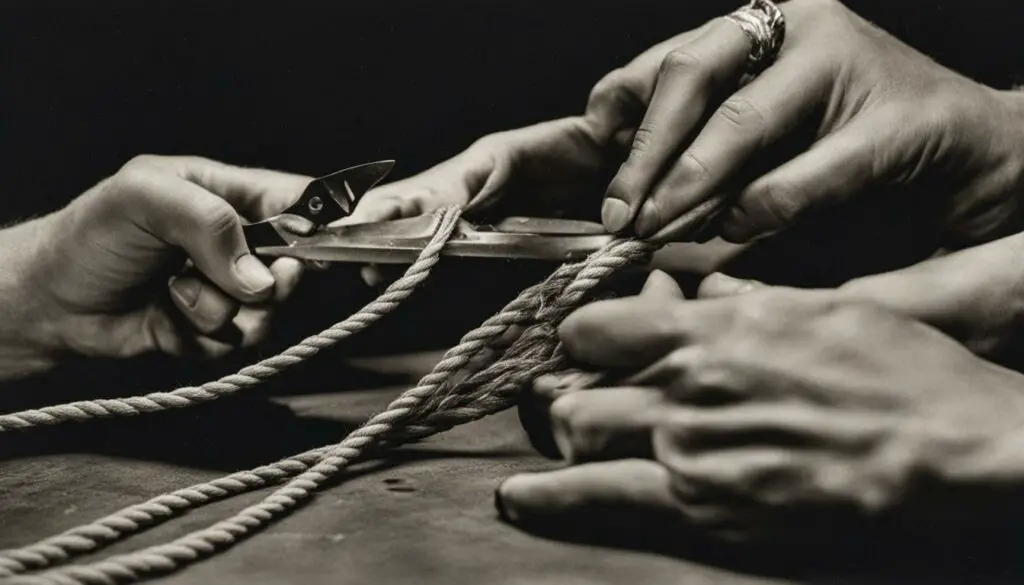
The Importance of Dental X-Rays
Dental X-rays play a crucial role in the dental examination and extraction process for cats. They allow the veterinarian to assess the underlying tooth structures and identify any potential problems that may not be visible during a physical examination alone. Dental X-rays are especially important for planning and performing oral surgery.
During a dental examination, X-rays help in detecting dental diseases such as tooth decay, periodontal disease, and root problems. These X-rays provide a detailed view of the teeth, roots, and surrounding bone, enabling the veterinarian to make informed decisions about the necessity of extractions and the most appropriate techniques to use.
“Dental X-rays provide valuable insights into the overall oral health of cats. They help us identify hidden problems, such as tooth root infections or impacted teeth, that may require immediate attention. Without dental X-rays, we would not have a complete picture of a cat’s oral health.”
Moreover, dental X-rays aid in ensuring the success of oral surgery procedures. They allow the veterinarian to visualize the extent of the tooth or bone damage, facilitating precise surgical techniques and reducing the risk of complications. By capturing detailed images of the affected area, dental X-rays assist in planning the surgical approach, optimizing the outcomes of tooth extractions and other dental procedures.
In summary, dental X-rays are an essential diagnostic tool in feline dentistry. They help veterinarians assess dental health, detect hidden problems, and plan surgical interventions. By utilizing dental X-rays, veterinarians can provide more accurate diagnoses and deliver effective treatment for maintaining the oral health of cats.
Table:
| X-Ray Benefits | Key Points |
|---|---|
| Accurate Diagnosis | Detect hidden dental problems |
| Preventive Care | Identify issues before they become severe |
| Treatment Planning | Plan surgical procedures and extractions |
| Surgical Precision | Reduce the risk of complications during oral surgery |
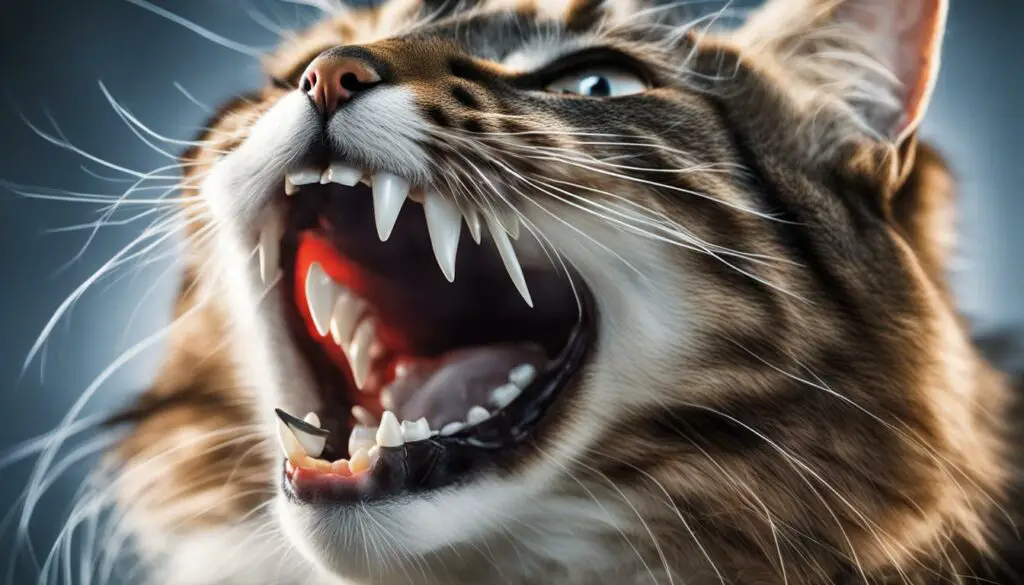
The Role of Dental Cleaning and Scaling
Dental cleaning and scaling are crucial components of maintaining a cat’s oral health. These procedures help prevent the development of dental plaque and calculus, which can lead to gum disease and other dental problems. Regular cleanings are essential for preventing the need for tooth extractions in the future.
During a dental cleaning, the veterinarian will remove any plaque and tartar buildup from the cat’s teeth. This process often involves the use of specialized dental tools, such as scalers and curettes, to gently scrape away the plaque and tartar from the tooth surfaces and below the gumline. Dental scaling is performed to ensure a thorough cleaning of all tooth surfaces, including those that may be difficult to access.
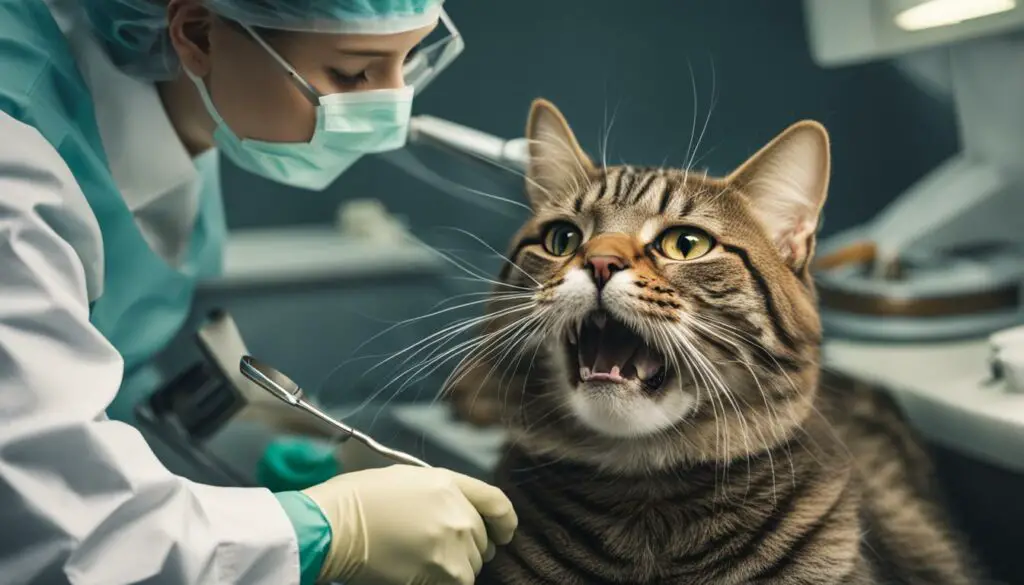
“Regular dental cleanings can help prevent the need for tooth extractions in the future.”
It is important to note that dental cleaning and scaling are typically performed under anesthesia to ensure the cat’s comfort and cooperation during the procedure. Anesthesia also allows for a more comprehensive examination of the teeth and gums. Additionally, pain management techniques may be employed to minimize any discomfort during and after the cleaning.
By prioritizing routine dental cleanings and scaling, cat owners can significantly reduce the risk of gum disease, tooth decay, and other oral health issues. Regular cleanings, combined with daily tooth brushing and the use of dental treats or toys, contribute to a healthy dental care regimen for cats.
| Benefits of Dental Cleaning and Scaling | Risks of Neglecting Dental Cleaning and Scaling |
|---|---|
|
|
Alternatives to Tooth Extraction
When it comes to addressing dental problems in cats, tooth extraction is not always the only option. Depending on the specific situation, there are several alternatives that can be considered to preserve the affected tooth and restore its function. These alternatives include:
- Dental Crowns: Dental crowns are custom-made caps that are fitted over a damaged tooth to restore its shape, strength, and appearance.
- Dental Bridges: Dental bridges consist of one or more artificial teeth that are anchored to neighboring healthy teeth, filling the gap left by a missing tooth.
- Dental Implants: Dental implants are titanium posts that are surgically inserted into the jawbone to replace missing teeth. They provide a strong and permanent foundation for artificial teeth.
- Dental Prosthetics: Dental prosthetics are removable devices such as dentures or partial dentures that can be used to replace multiple missing teeth.
These alternatives aim to restore the function and appearance of the affected tooth without the need for extraction. However, it is important to note that not all dental problems can be treated with these alternatives, and the suitability of each option will depend on various factors such as the condition of the tooth, the overall oral health of the cat, and the recommendation of the veterinarian.
In some cases, a combination of treatments may be recommended to achieve the best possible outcome. It is essential to consult with a veterinarian who specializes in feline dentistry to determine the most suitable alternative for your cat’s dental needs.
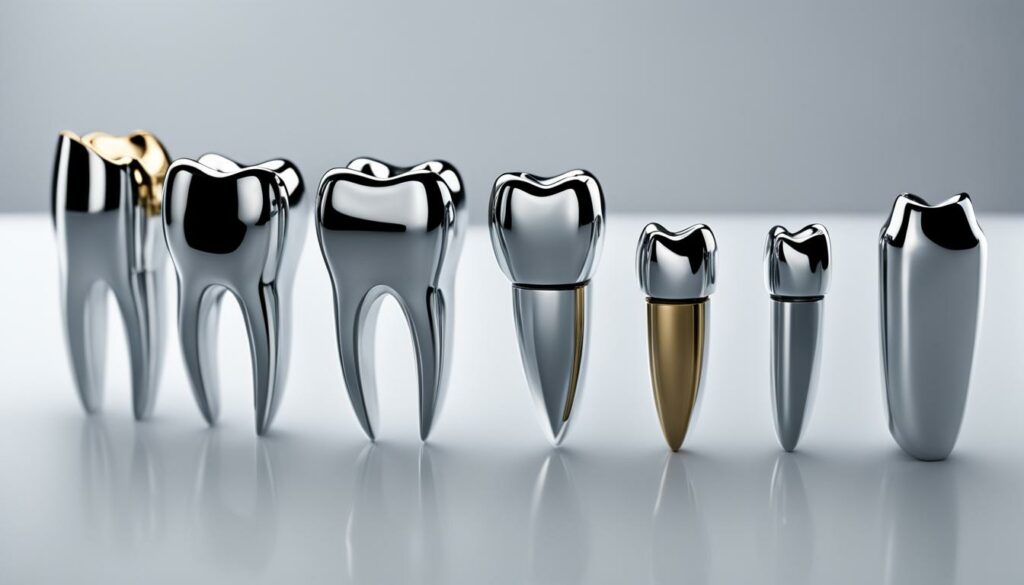
Example Table: Comparing Dental Treatment Options
| Treatment Option | Pros | Cons |
|---|---|---|
| Dental Crowns | – Restores the shape, strength, and appearance of the affected tooth – Preserves the natural tooth structure – Can be long-lasting with proper care |
– Requires a healthy tooth structure to support the crown – May require multiple dental visits for preparation and placement |
| Dental Bridges | – Fills the gap left by a missing tooth, improving chewing and appearance – Can prevent the shifting of adjacent teeth – Non-invasive option |
– Requires healthy adjacent teeth to support the bridge – May require removal of tooth enamel from adjacent teeth |
| Dental Implants | – Provides a strong and permanent replacement for missing teeth – Does not rely on adjacent teeth for support – Preserves bone health |
– Requires a surgical procedure for placement – May require additional procedures, such as bone grafting, for proper support – Longer treatment timeline |
| Dental Prosthetics | – Provides a removable solution for multiple missing teeth – Improves chewing function and appearance – Non-invasive option |
– Requires proper maintenance and care – May have an adjustment period for the cat – Can cause discomfort if not properly fitted |
Consultation with a Dental Specialist
When it comes to complex dental cases in cats, it’s crucial to consult with a dental specialist who has expertise in feline dentistry. These specialists can provide a more comprehensive evaluation of your cat’s dental health and develop personalized treatment plans to address specific issues. They have the knowledge and experience to perform specialized procedures and recommend the most appropriate course of action for your cat’s needs.
Prior to any dental procedure, a dental examination by a specialist is essential. This examination allows the specialist to assess your cat’s oral health and identify any underlying problems that may require attention. It also provides an opportunity to discuss any pre-operative considerations or concerns you may have.
The dental specialist will work closely with you and your veterinarian to ensure a seamless transition from the pre-operative phase to the actual procedure. They will provide guidance on any necessary preparations, such as fasting requirements or medication adjustments, to ensure the best possible outcome for your cat.
Post-operative care is equally important, and the dental specialist will play a crucial role in this phase as well. They will provide detailed instructions on how to care for your cat following the procedure, including pain management, dietary restrictions, and monitoring for any signs of complications. They will also schedule follow-up appointments to track your cat’s progress and make any necessary adjustments to the treatment plan.
Consulting with a dental specialist can offer peace of mind and give your cat the best chance at optimal oral health. Their expertise and specialized care can make a significant difference in the outcome of dental procedures, ensuring that your cat receives the highest quality treatment from start to finish.
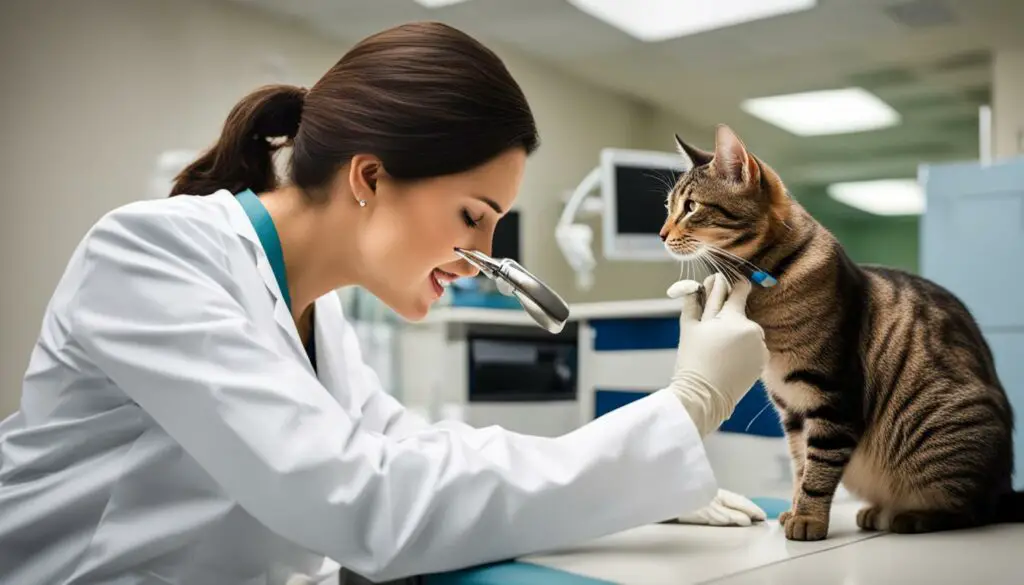
| Benefits of Consulting with a Dental Specialist |
|---|
| Specialized expertise in feline dentistry |
| Comprehensive evaluation of dental health |
| Personalized treatment plans |
| Ability to perform specialized procedures |
| Close collaboration with your veterinarian |
| Guidance on pre-operative preparations |
| Detailed post-operative care instructions |
Importance of Dental Hygiene for Cat Owners
As a cat owner, I understand the importance of maintaining good oral hygiene for my furry friend. Just like humans, cats can also suffer from dental problems, including periodontal disease, gingivitis, and tooth decay. Taking proper care of their dental health is crucial to ensure their overall well-being.
Dental care for cats goes beyond just brushing their teeth. It involves regular check-ups with a veterinarian, professional cleanings, and appropriate dental treatments when needed. By prioritizing oral health care, we can prevent painful dental issues and improve our cats’ quality of life.
There are several simple steps we can take as cat owners to promote good dental hygiene. Regular tooth brushing is one of the most effective ways to prevent plaque buildup and maintain oral health. Using cat-friendly toothpaste and a soft-bristled toothbrush, we can gently brush their teeth a few times a week. It’s important to start this routine early to get our cats accustomed to the process.
In addition to brushing, there are dental care products available specifically designed for cats, such as dental treats or toys. These products can help reduce plaque and tartar buildup and contribute to their oral health. However, it’s important to consult with a veterinarian to ensure that the dental care products we choose are safe and appropriate for our cats.
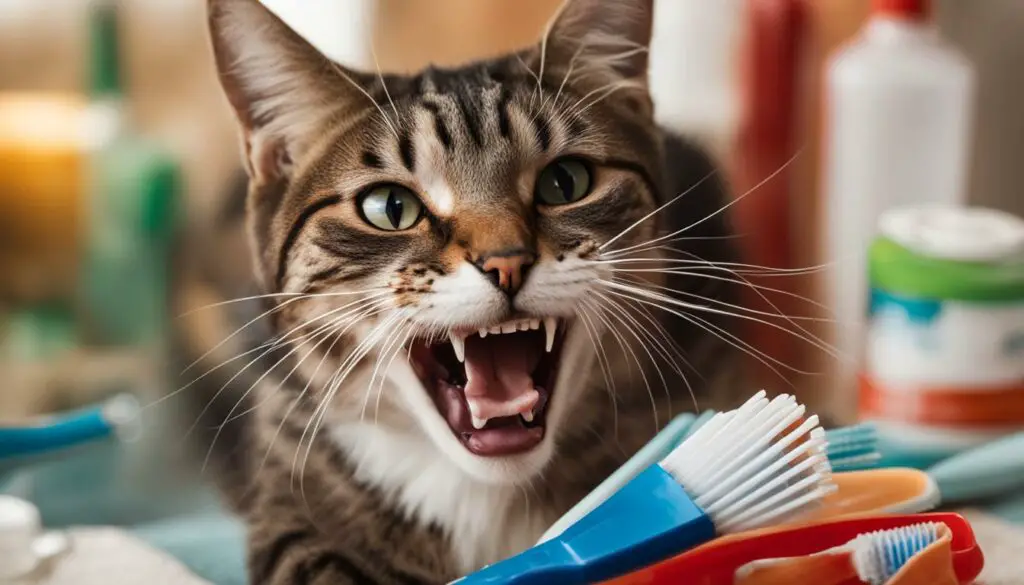
The Benefits of Dental Care for Cats
“Proactive dental care for cats can help prevent painful dental conditions, improve their overall health, and potentially save on future veterinary costs.”
Regular dental care for cats offers several benefits:
- Prevention of dental problems: By brushing our cats’ teeth and providing appropriate dental care, we can help prevent dental problems such as periodontal disease and tooth decay.
- Improved overall health: Good dental hygiene is linked to better overall health in cats. Dental problems can lead to infections and other systemic issues that can impact their overall well-being.
- Savings on veterinary costs: Proactive dental care can help prevent the need for more extensive dental treatments and extractions, potentially saving us money on veterinary bills in the long run.
By making dental care a priority, we can ensure our cats have healthy teeth and gums, leading to a happier and healthier life. Consult with a veterinarian for specific dental care recommendations and regular check-ups to keep our furry friends‘ smiles bright.
Understanding Dental Costs
When it comes to cat tooth extraction, it’s important to understand the costs involved. The price can vary depending on several factors, including the location of the veterinary clinic, the complexity of the procedure, the experience of the veterinarian, and any additional treatments that may be required.
On average, the cost of cat tooth extraction ranges from $300 to $1000 per tooth. However, it’s crucial to consult with your veterinarian to get a more accurate estimate for your specific cat’s needs. They will be able to assess the complexity of the procedure, the overall health of your cat, and any additional treatments that may be necessary.
Keep in mind that while the cost of tooth extraction may seem high, it is an important investment in your cat’s oral health. By addressing dental problems early on, you can prevent further complications and potential pain or discomfort for your feline friend. Remember, your veterinarian is the best resource for understanding the breakdown of costs and determining the most appropriate course of action for your cat’s dental health.
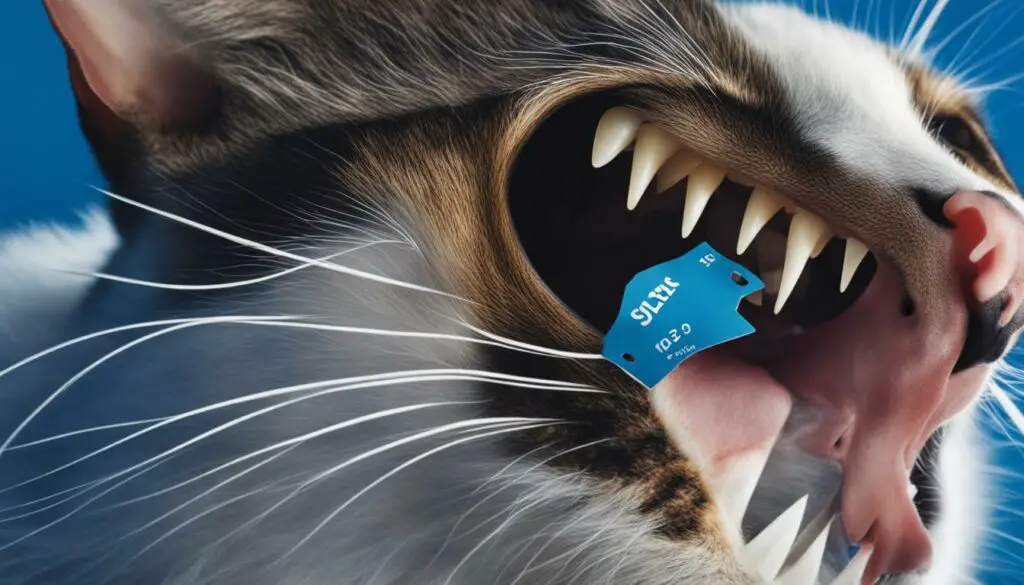
Factors Affecting Dental Costs
Several factors can contribute to the overall dental costs for cats. One major factor is the use of anesthesia or sedation during the procedure, which ensures the comfort of your cat and allows the veterinarian to perform the extraction safely. The type and complexity of the extraction procedure, as well as the need for specialized dental instruments, can also impact the cost.
In addition, the specific dental treatments or medications required, such as pain management or antibiotics, can add to the overall cost. It’s essential to have a thorough discussion with your veterinarian to understand these factors and the breakdown of costs before proceeding with the tooth extraction procedure.
| Factors | Impact on Cost |
|---|---|
| Location of the veterinary clinic | The cost of living and practice expenses can vary depending on the location, which can influence the overall cost of dental procedures. |
| Complexity of the procedure | The difficulty and complexity of the tooth extraction can affect the cost, as more complex extractions may require additional time and expertise. |
| Veterinarian’s experience | Veterinarians with more experience and expertise in dental procedures may charge higher fees for their services. |
| Additional treatments required | If your cat requires additional treatments such as X-rays, dental cleanings, or antibiotics, these can add to the overall cost. |
Understanding the factors that contribute to dental costs can help you make an informed decision about your cat’s oral health. By discussing these factors with your veterinarian and exploring your options, you can ensure that your cat receives the necessary dental care within a budget that works for you.
Factors Affecting Dental Costs
When it comes to cat tooth extraction, there are several factors that can influence the overall dental costs. These factors include the use of anesthesia or sedation during the procedure, the need for specialized dental instruments, and any additional treatments or medications required. Let’s take a closer look at each of these factors:
Anesthesia and Sedation
Administering anesthesia or sedation is crucial to ensure your cat’s comfort during the dental extraction procedure. The cost of anesthesia or sedation will depend on the type and duration of the procedure, as well as the dosage required for your cat’s specific needs. Your veterinarian will determine the appropriate levels of anesthesia or sedation based on your cat’s health condition and the complexity of the extraction.
Dental Instruments
The dental instruments used during the extraction can also impact the overall costs. Specialized instruments may be required to safely and effectively remove the tooth or address any underlying dental issues. These instruments are designed for precision and may need to be sterilized or replaced after each procedure, contributing to the overall dental costs.
Additional Treatments and Medications
In some cases, additional treatments or medications may be necessary before, during, or after the tooth extraction. This could include antibiotics to prevent or treat infection, pain management medications to alleviate discomfort, or other treatments specific to your cat’s dental condition. These additional treatments and medications can add to the overall dental costs but are essential for your cat’s well-being and recovery.
It’s important to discuss these factors with your veterinarian to get a clear understanding of the breakdown of costs before moving forward with the extraction. By understanding the factors that can affect dental costs, you can make informed decisions about your cat’s dental health and budget accordingly.
Considering the Value of Dental Health
As a cat owner, it is important to recognize the significant value of maintaining your cat’s dental health. Good oral health plays a crucial role in your cat’s overall well-being and can contribute to a longer and happier life. By prioritizing dental care, you can help prevent pain, discomfort, and potential complications that can arise from untreated dental problems.
Regular dental check-ups and cleanings can help detect any issues early on and allow for prompt treatment. This can save you and your cat from more extensive and costly dental procedures in the future. Furthermore, preventive measures such as tooth brushing and the use of dental treats or toys can help maintain your cat’s oral health between veterinary visits.
“A healthy mouth leads to a healthier cat.”
Investing in your cat’s dental health not only benefits their physical well-being but also contributes to their overall happiness. Imagine the discomfort your cat could experience from dental problems and the impact it would have on their quality of life. By providing proper dental care, you can ensure that your furry friend remains comfortable, happy, and free from unnecessary pain.
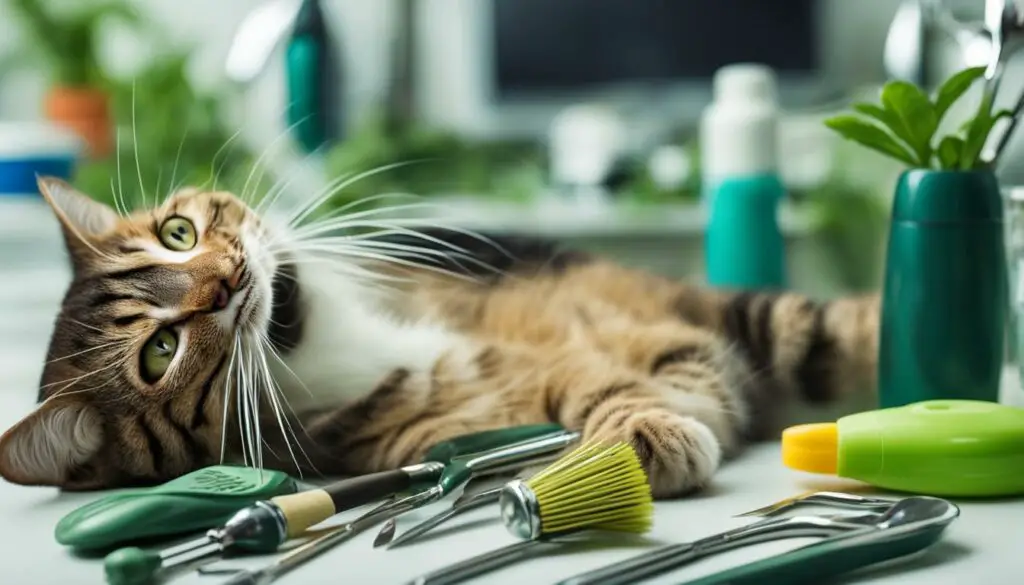
| Value of Dental Health | Benefits |
|---|---|
| Prevents dental pain | Ensures your cat’s comfort and well-being |
| Prevents periodontal disease | Reduces the risk of gum disease and tooth loss |
| Improves overall health | Oral health is linked to overall systemic health |
| Saves money in the long run | Preventive care is more cost-effective than extensive treatments |
| Enhances quality of life | Your cat will be happier and healthier |
Conclusion
In conclusion, cat tooth extraction is an important procedure that can address dental problems in cats and improve their overall well-being. While the cost of extraction can vary, it is crucial to prioritize your cat’s dental health to prevent pain, discomfort, and potential complications. Regular dental care, including professional cleanings, can help maintain oral hygiene and minimize the need for extractions in the future.
Consulting with a veterinarian is essential to determine the specific dental needs of your cat and get an accurate estimate of the costs involved. It is also crucial to follow any post-operative care instructions provided by your veterinarian to ensure a smooth recovery for your furry friend.
By investing in your cat’s dental health and practicing good oral hygiene, you can ensure that your beloved pet enjoys a happy and healthy life for years to come. Remember, prevention is always better than cure when it comes to your cat’s dental well-being.
FAQ
How much does cat tooth extraction cost?
The cost of cat tooth extraction can vary depending on various factors such as the location, the complexity of the procedure, the veterinarian’s experience, and any additional treatments required. On average, the cost can range from $300 to $1000 per tooth. It is important to consult with your veterinarian to get a more accurate estimate for your specific cat’s needs.
Why is cat dental health important?
Maintaining proper dental health in cats is crucial for their overall well-being. Poor oral hygiene can lead to various dental problems such as periodontal disease and gingivitis, which can cause pain, discomfort, and even tooth loss. Regular dental care, including professional cleanings and tooth extractions when necessary, can help prevent these issues and ensure your cat’s oral health.
What are the common reasons for cat tooth extraction?
Several common reasons why a cat may require tooth extraction include severe dental decay or infection, abscesses, fractured teeth, and root canal failure. In some cases, extraction may be the only option to alleviate pain and prevent further complications. Your veterinarian will determine the best course of action based on your cat’s specific dental problems.
What does the dental extraction procedure for cats involve?
The dental extraction procedure for cats typically involves the use of anesthesia or sedation to ensure their comfort and to allow the veterinarian to perform the extraction safely. The process may vary depending on the tooth being extracted and the complexity of the procedure. Pain management techniques are also employed to minimize discomfort during and after the extraction.
What is involved in the recovery and post-operative care after cat tooth extraction?
After a cat’s tooth extraction, they will require a period of recovery. This usually involves keeping them comfortable and providing appropriate pain management. Your veterinarian may prescribe medications to manage pain and prevent infection. Dental sutures may also be used to help with the healing process. It is important to follow any post-operative care instructions provided by your veterinarian.
What are the potential complications and risks associated with cat tooth extraction?
Like any medical procedure, there are potential complications and risks associated with cat tooth extraction. These can include bleeding, infection, damage to surrounding teeth or structures, and delayed healing. Your veterinarian will discuss these risks with you and take steps to minimize them during the procedure.
Why are dental X-rays important in cat dental care?
Dental X-rays play a crucial role in the dental examination and extraction process for cats. They allow the veterinarian to assess the underlying tooth structures and identify any potential problems that may not be visible during a physical examination alone. Dental X-rays are especially important for planning and performing oral surgery.
What is the role of dental cleaning and scaling in cat dental health?
Dental cleaning and scaling are important preventive measures for maintaining a cat’s oral health. These procedures involve the removal of dental plaque and calculus buildup, which can lead to gum disease and other dental problems. Regular cleanings can help prevent the need for tooth extractions in the future.
Are there alternatives to tooth extraction for cats?
In some cases, tooth extraction may not be the only option for addressing dental problems in cats. Depending on the specific situation, alternatives such as dental crowns, bridges, implants, or prosthetics may be considered. These options aim to restore the function and appearance of the affected tooth without the need for extraction.
When should I consider consulting a dental specialist for my cat’s dental problems?
In complex dental cases, it may be necessary to consult with a dental specialist who has expertise in feline dentistry. A dental specialist can provide a more in-depth evaluation, perform specialized procedures, and offer personalized treatment plans. They can also provide pre-operative and post-operative care to ensure the best possible outcome for your cat.
How can I prioritize dental hygiene for my cat?
As a cat owner, it is essential to prioritize dental hygiene as part of your overall healthcare routine for your pet. Regular tooth brushing, the use of dental treats or toys, and routine dental check-ups can help maintain your cat’s oral health and minimize the need for tooth extractions in the future. Your veterinarian can provide guidance on specific dental care practices for your cat.
What factors affect the cost of cat tooth extraction?
The cost of cat tooth extraction can vary depending on factors such as the location, the complexity of the procedure, the veterinarian’s experience, and any additional treatments required. Anesthesia or sedation, specialized dental instruments, and any additional treatments or medications can also impact the overall dental costs. It is important to discuss these factors with your veterinarian and understand the breakdown of costs before proceeding with the extraction.
What is the long-term value of investing in cat dental health?
While the cost of cat tooth extraction may seem high, it is essential to consider the long-term value of maintaining your cat’s dental health. Good oral health can prevent pain, discomfort, and potential complications that can arise from untreated dental problems. Investing in your cat’s dental care can ultimately save you money and ensure a better quality of life for your furry friend.

